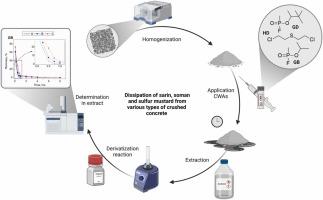Dissipation of sarin, soman, and sulfur mustard from various types of crushed concrete
IF 12.2
1区 环境科学与生态学
Q1 ENGINEERING, ENVIRONMENTAL
引用次数: 0
Abstract
The behavior of chemical warfare agents (CWAs) on urban materials, such as concrete, significantly impacts forensic and military responses to chemical incidents. This study examined the persistence and degradation mechanisms of sarin (GB), soman (GD), and sulfur mustard (HD) on three types of commonly used concrete with varying water-cement ratios. Over two months, we evaluated the effects of concrete composition, temperature, and fragment size on CWA behavior. Half-lives and activation energies for CWA dissipation were calculated under various conditions. Results showed that concrete properties and external temperature strongly influenced dissipation rates. G-series agents underwent rapid hydrolysis, forming methylphosphonates, while HD degradation involved elimination, nucleophilic substitution, and oxidation, producing several previously unreported byproducts. Smaller concrete fragments increased recovery values and accelerated degradation due to greater surface area exposure, and higher temperatures further enhanced dissipation rates, particularly for volatile agents. Differences in dissipation among concrete types were linked to their physical and chemical properties, notably water-cement ratios. This study highlights the challenges of detecting CWAs due to their rapid penetration and transformation in concrete and provides insights for improving sampling, identification, and decontamination strategies under realistic conditions.

求助全文
约1分钟内获得全文
求助全文
来源期刊

Journal of Hazardous Materials
工程技术-工程:环境
CiteScore
25.40
自引率
5.90%
发文量
3059
审稿时长
58 days
期刊介绍:
The Journal of Hazardous Materials serves as a global platform for promoting cutting-edge research in the field of Environmental Science and Engineering. Our publication features a wide range of articles, including full-length research papers, review articles, and perspectives, with the aim of enhancing our understanding of the dangers and risks associated with various materials concerning public health and the environment. It is important to note that the term "environmental contaminants" refers specifically to substances that pose hazardous effects through contamination, while excluding those that do not have such impacts on the environment or human health. Moreover, we emphasize the distinction between wastes and hazardous materials in order to provide further clarity on the scope of the journal. We have a keen interest in exploring specific compounds and microbial agents that have adverse effects on the environment.
 求助内容:
求助内容: 应助结果提醒方式:
应助结果提醒方式:


